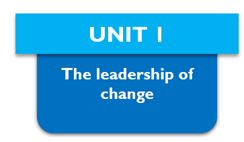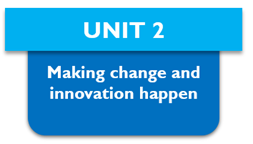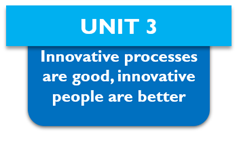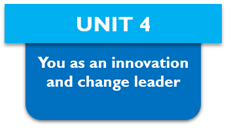Module 3 – Making change and innovation happen across your PCN
Module 3
Welcome to Module 3 – Making change and innovation happen across your PCN
Module 3 focuses on how one can initiate change and lead innovation teams across your PCN. It offers a deeper appreciation of why good governance underpinned by shared values, culture, systems, and processes is important. Whilst important, of themselves, they are not enough. This is because, as we shall explore, the key ingredient for effective partnerships is the collaborative endeavors of people, facilitated and supported by leaders like you (the change agents) willing to facilitate and make change happen.
Module 3 will help build your confidence in using problems solving techniques to help cement the adoption of different approaches to innovation and change, and it will allow you to explore your own innovation styles and preferences and better understand the preferences of team members.




Unit 1 – The Leadership of change?
An essential first step in leading innovation and change across our PCN is to understand what exactly we mean by it, especially in a health and care context. The everchanging landscape across health and care brings with it pressures on our system, our organisations and our partnership to change the way we do things.
The phrase ‘new ways of working’ is now mentioned in most national policies, articles and research, but what exactly do we mean by ‘new’? Is it a small incremental change to a process? Is it a transformational change at system level? Is is something we have done before or is it completely innovative? What are the implications? and the list of questions can continue…
So, what do we need to know about change and innovation? What do we need to have in place to enable it? If we are to bring transformation change and innovation across our PCN, some of the things we can start doing are:
Communicate – explain both the ‘WHAT’ and the ‘WHY’
Collaborate – bring people together and refuse to tolerate unhealthy competition
Commit – make sure your behaviours support change by offering aircover, being resilient and be willing to step outside the comfort zone
But what else? Unit 1 of Module 3 explores the context and enablers of change and transformation across health and social care, and prompts you to look at its various dimensions, from the narrative of change, your change-makers to the leadership required of you.
Learning Outcome:
A deeper appreciation of the leadership of innovation and change across the health and care sector.
Unit 2 – Making Change and Innovation Happen?
Once we understand the concept of change and innovation across health and care, the next step is to understand the processes by which we make it happen. Having a structured approach to the change process and problem solving, adopted by all, is one of the best ways to help accelerate the performance of PCN working.
Prior to Primary Care Networks, each practice was largely left to its own devices about innovation, change and ways of problem solving. This ad-hoc approach, whilst having some advantages, also presented structural problems. Inefficiencies in the adoption of new practices, lead to inconsistencies in services and of themselves become further barriers to GP practices peer-to-peer working. Competitive practices and disputes over the methodologies offered by one practice to another further hindered collaboration and the building of primary care resilience through scale. By gaining agreement to use a co-created process with the other practices making up your PCN, you can overcome the ‘battles of processes’ and ensure the change or innovation you want to make is successful.
So how can a single change and problem-solving methodology help you?
A key factor when supporting PCN working is the adoption of a common change methodology and a suite of problem-solving tools.
Collaborative leadership is, according to the academics David Archer and Alex Cameron (2009), ‘a management style and skill set that engages all participants by designing constructive processes for working together, convenes appropriate stakeholders and facilitates and sustains their interaction2’.
These leadership skills are echoed by other commentators and researchers. Tracy Crevar (2007) talks about, ‘clearing the clutter’ (clearly defined goals), ‘breaking down silos’ (cross functional leadership teams), encouraging a ‘growth catalyst role’ and ‘getting everyone involved’3.
The introduction by you, as a collaborative facilitator and change agent, of a collaborative change methodology and problem-solving technique, agreed and adopted by all will clear clutter, break down silos and get everyone involved.
It will also help you forge more effective multi-agency, multi-disciplinary team working across the PCN team. Team work best when they understand the processes and share a methodology for change and problem solving. They can focus on the tasks at hand rather than wasting time and energy arguing over the process and approach.
Unit 2 explores two different change methodologies that have the potential become the adopted approach across your PCN. The first is the NHS Change Model, and the second is the ‘collaborative incubator’ model, together with a recommended problem-solving framework which you can use to facilitate the incubation process for any workstreams/project you are doing across your PCN.
Learning Outcome:
Developing your confidence in using various change methodologies and problems solving techniques to help cement the adoption of one approach to innovation and change across your PCN
Unit 3- Innovative Processes Are Good, Innovative People Are Better
As we have outlined in unit 2, whilst the adoption of common change and innovation processes is important, of itself it is not enough. Innovation is all about people, their ideas, ability to collaborate and the energy they bring to making change happen. Innovation processes are good, innovative people are even better! How do you ensure you have the right balance of people in the room that make up your innovation team?
This unit will help you better understand how to assemble the right mix of people to make innovation stick across your PCN, by looking at the range of innovation leadership tendencies and at how best we can ensure that diversity is the core enabler of change and innovation that is transformational.
Learning Outcome:
Building your understanding of the human and leadership dynamics of innovation and change, and how to enable innovation teams to flourish
Unit 4 – You as a Innovation and Change leader
The first three units are focused on the leadership of change, change processes and methodologies and innovation teams. The last unit, Unit 4, returns back to you, exploring your personal preferences and resilience when leading change. Here we will delve deeper into your MBTI preferences to discover what kind of ideas you prefer and your personal preferences when dealing with change
Unit 4 will also provide you with an opportunity to reflect on your learning from the whole programme, and take a holistic view of the skills and behaviours required to be a successful PCN leader, and develop your action plan going forward
Learning Outcome:
Building your confidence in your role as an innovation and change leader
What materials do you have to go through for each Unit?
On the PCSA platform, you will have a video for each Unit outlined above, introducing you to the main theory and practice for that respective unit, as well as the self-reflective activities which you will need to fill in the Module 3 workbook.
We suggest you have your workbook either as a hard-copy or opened on your computer while watching the videos and undertake the self-activities in the workbook while progressing through the various units of learning.
The self-activities for each Unit of Learning for Module 3 are outlined in the workbook. To ensure the learning is embedded as you progress through the programme and the learning outcomes achieved, we recommend you undertake the self-activities in their entirety.
Remember to download your workbook for Module 3 on your PC or print it as a hardcopy before progressing further.
